Australian Wildlife Blog
 Photo by Google
Photo by GoogleWhich wildlife do you see?
This is a collection of the wildlife I’ve seen and photographed in Australia. The purpose of this blog is to study wildlife, to observe their traits & behaviors. Because they are co-existing with us, it’s deemed worthy a study. This is an exercise of curiosity. Perhaps, this curiosity will lead me to understand how to live along with them and allow me to better inform decisions in regard to their habitats and conservation in the wild.
| Species & Family & Picture Taken | Observation - Traits - Characteristics |
|---|---|
| Tasmanian devil Dasyuridae Sarcophilus harrisii  24 April 2020 - East Coast NatureWorld, Tasmania | Description: Here are the infamous Tasmanian devils, a species that has been categorized as “Endangered” in the world. They exist only in Tassie as far as we know, it is said that they’ve gone extinct on the mainland 3,000 years ago. These little ones are under the great care of the wildlife refuge center here in Tassie. They’re fed 3 times a day. If you’re lucky enough to come in at one of those times you’ll get a narrative bio from the feeder, an extremely knowledgeable person in Tasmanian devil’s behavior, disease, breeding and life cycle. They have powerful jaw, they are scavengers and feed on dead animals. They can help to keep invasive species like the red fox in check. They are suffering from a particular modern day disease called Devil Facial Tumour Disease (DFTD) that is currently being studied and a vaccine is coming close. The guide/feeder says that the solution is to inject the little devil several times at intervals which is not a sustainable method for a mass population. |
| Little corella Cacatuidae Cacatua sanguinea  7 March 2020 - East Coast NatureWorld in Tasmania | Description: When I came over to say hello, this Little Corella clings on to her peak one square at a time to get to me. She was extremely sociable and let me pet her, even says “hello” and “whatchu doing”. It is no surprise to find a talking corella because it is in the parrot order. A pet corella can learn to talk by mimicking its owner. It is possible that people who take care of her at this wildlife rescue taught her these phrases. For this reason, I can see why some people enjoy their company as pets. Interestingly, a corella is loyal to one mate whether that is a bird or a person. Physical traits:This Little Corellas is also known as short-billed corella. It’s mostly white, soft and slick feathers, blue color membrane around its eyes. It has tangerine-mild red color between its eyes and bill, around is neck. Habitat: Little Corellas are widespread in timbered areas on the mainland. They roost and feed in large flocks for protection from predators. They feed mainly on grass seeds. They can travel long distances to find food and water when they’re not annoying farmers by eating grain crops. |
| Sugar gliders Petaurus breviceps Petauridae  13 March 2020 - East Coast NatureWorld, Tasmania | Description: These guys are rescued sugar gliders, they are arboreal and nocturnal. They carry their babies in the mother’s pouches as do marsupials! Although they are omnivores, their preferences are sweet of taste like nectar or tree sap, hence the name. When people adopt them as pets, they tend to develop a calcium deficiency due to lack of movement and “gliding”! They can glide up to 50 meters or 165 feet. It is more often that they glide from one tree to another at a much smaller distance than this, around 6-10 meters. Uhh, that’s still a long way. I’d fall flat on my face if I try! Physical traits: grey coat, long and narrow black strip on top of the forehead from ear to eyes. Five paws that look flat but are quite agile at grabbing fruits. Large black eyes facing slightly forward. An adult sugar glider is about 16 cm, they are tiny! Habitat: forests and woodlands. |
| Laughing kookaburra Kingfisher Dacelo novaeguineae 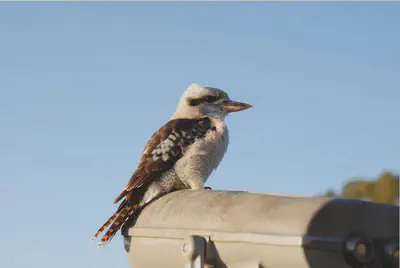 16 March 2020 - Dandenong Mountain Ranges | Description: The distinct laughter caught my attention after I parked the car in SkyHigh, top of Mt. Dandenong. It went ‘koo-koo-ka-ka-kook’. Their rauscous all or laugh is a sign of establishing territory and they are the largest of the kingfisher. according to the Nature Conservatory of Australia. There were quite a few of these fellows along with the Magpie and Crimson rosella among the tree branches. This fellow came over and rest regally on the telescope with the cold wind bellowing its mohawk. Physical traits: Patches of light blue on its brown wing. Average to be 40-48 cm. Light, prominant brown eyes. Thick yellowish bill. White plumage with brown strips spanning across and top to bottom where feet are. Orange strips on its brown tail. There is another brown wedge strip kind of like a cat eyeliner drawn to the side its eyes. Habitat: Habitat: Open forest, eucalyptus forest, woodland. |
| Wedged-tailed eagle Accipitridae Aquila audax 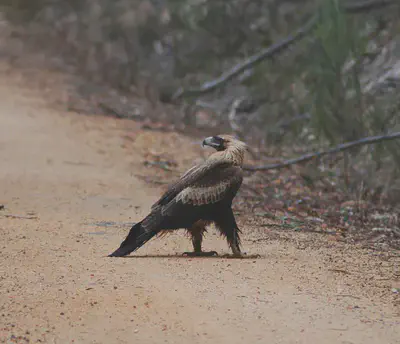 24 March 2020 - Grampians National Park | Description: We were driving on this dirt track in the Grampians when we spotted this wedged-tailed eagles perching on a low lying branch atop the creek running parallel to the track. As we rolled closer, this creature with roughly a 100 cm wingspan, took off right in front of our car and landed right on the road. He has a sharp hook bill, light bronze striking hairdo and neck, brown feathers on his wings and legs. The talons on his feet span 180 degree wide and extremely sharp. I observed his wedged tail as he hovered low to the ground. I’m unsure how old this eagle is, it is said that the younger ones have lighter and reddish brown wings, females tend to be paler than males. Their eyesight extends to ultraviolet bands, making their gaze ever more awestruck, I wonder what they see around them and how they view the world different from us. They can soar up to 2000 meters or 3280 ft. They are monogamous which means they mate for life. The Kulin Aboriginals in Victoria consider the wedged-tailed eagle as God, or Bunjil, the creator of the Earth and all living things including people. They represent the month of December in the Kulin’s calendar. It is said that Bunjil stopped the sea level from rising when the people came to him asking for help. Bunjil raised his spear and directed the sea to stop rising under the promise that the fighting between Boonwurrung and other Kulin nations ceases and that they’d take care of their land. “The place the Kulin then chose to meet is where the Parliament of Victoria is now located. This land will always be protected by the creator, Bunjil, who travels as an eagle.” |
| Emu Dromaiidae Dromaius novaehollandiae  26 March 2020 - Halls Gap, Victoria and East Coast NatureWorld, Tasmania | Description: I first encountered an emu in Tasmania, at a wildlife sanctuary. The guy in the pictures below took care of this emu since he was a baby. His family-like behavior toward the emu gave me the impression that this second largest and flightless bird in the world is harmless and potentially friendly. I was particularly amazed at the emu’s feet. It has 3 large forward facing toes that look scaly, the middle one is the largest. The saggy feathers are long and gray-brownish, which reminds me of the hair of a broom. When standing erected, they’re are 1.6 - 1.9 meters tall! The breeding behavior is unlike anything I have seen so far, after mating, the male incubates the large green eggs without “drinking, feeding, defecating, or leaving the nest” while the female moves on, sometimes, can mate with other males . The young ones are often by their father until they’re able to feed themselves and the female does not assist in feeding them. An emu can run up to 50 km or 30 miles. This is the main reason why the emus won the battle against the Australian farmers in 1932. As humorous as it sounds, the West Australian farmers were allegedly fed up at the invasion and destruction of crops by the emu, they called upon the Army for help and started what we know today as the Great Emu War of 1932. Even with machine guns, it was incredibly difficult to get a shot at any emu, rumor has it that not a single bird was killed using this tactic. Though one that did die took about 5 bullets, this was clearly a very costly war. Habitat: According to the Australian Museum, emus live in sclerophyll forest and savanna woodland and rarely found in rainforest or very arid areas. |
| Eastern water skink Scincidae Eulamprus quoyii  30 March 2020 - Lake Mountain Summit, Yarra Ranges National Park | Description: I saw this fella on the summit of Lake Mountain. He was resting on this sun-baked rock with a brown and gold scaled body. There are dark brown lines running on both sides of the body with yellow dots scattered. The colors get much lighter toward the tail. I reckon he is about 20 cm long but they can grow up to 30cm! There are 4 limbs, the 2 hind limbs have 5 toes each and are much longer than the 2 front limbs with 3 toes each. He has a visible nostril in the front, light yellow underbelly and black dots on his long tail. I am quite certain that this skink would have dropped his tail if I had tried to pick him up. This species is said to be endemic in Eastern Australia and is a great pest-control for gardens, breeding in spring . They feed on water beetles, insects, snails, native fruits, they don’t have to eat everyday! They are also known as golden water skinks which makes sense given their colors! They are diurnal! |
| Eastern grey kangaroo Macropodidae Macropus giganteus 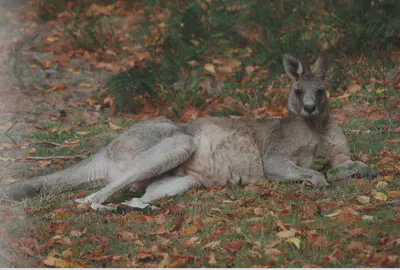 April 10 2020 - Halls Gap, Victoria | Description: Halls Gap is home for eastern grey kangaroos. They are seen feeding or resting under shades in the town’s recreational oval or inside your backyard. One kangaroo in particular, Mr. Brown, likes to sneak into the rubbish bins at night for more food. They have short arms and strong long legs with giant toes which allows them to hop up to 55km/hr in top speed. However at birth, the kangaroo is a 2 cm long, pink and hairless, without legs at all! This one in our backyard looks to be as heavy as 68kg and about 1.5 meters. It is misleading to portray the kangaroos in the media as cute and friendly national icons, this makes visitors forget that these powerful native species can hurt when feel threatened. Mr. Brown here is habituated to human which can make him aggressive to human. It is said on the official guide to keep our head and arm low, wait until the kangaroo moves away or retreat in a crouched position. They are great boxers, the dominant male in the group remains until challenged and defeated in a boxing match by another male. Further reading, I found out that there are 3 main species of kangaroo in Australia: red kangaroos in Central Australia, eastern kangaroos in the East and western grey kangaroos in the southern Australia up to western Victoria, southern NSW and Queensland.Resident to long-distance migrant. The National Geographic Wildlife documentary shows that the red kangaroo is the species most adaptable in the arid environment and high temperature as well as droughts. They can retain keep water in their kidneys whereas their grey cousins need to drink water more regularly. Grey kangaroos need shade more than the red, the red fur reflects 30% of solar radiation to keep them cool. They spread saliva on their forearms to keep cool. They can dig into the sand to get cooler soil before resting on them. Their predators are wedged-tail eagle and dingos! |
| Australian King-parrot Psittacidae Alisterus scapularis 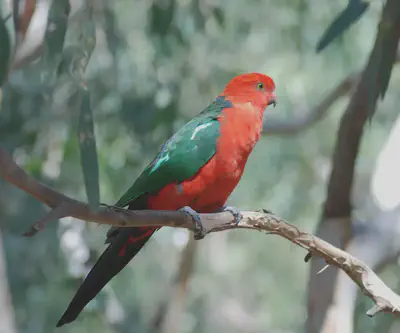 12 April 2020 - Kennett River, Victoria | Description: Meet these fine Australian King Parrots. The male and female both have bright red belly and green back and wings. The female has green head and breast. Aside from being endemic to Australia, they have sedentary lifestyle, inhabit mostly in the east coast rainforests and sclerophyll forests. Here at this river, these parrots would eat the rice grains out of my hands after spending sometime making sure that I wasn’t a threat from a distance. According to the internet, their eggs are white and laid on a bed of decayed wood-dust at the bottom of a deep hollow trunk of a tree. Did you know this bird species has 4 types of cone in their eyes and can see into ultraviolet range whereas we have only 3 types (red, blue and green)? Also, a male king parrot takes 3 years to completely develop his striking scarlet red head and underpart prior to which he looks like his counterpart female in green? |
| Short-beaked echidnas Tachyglossidae Tachyglossus aculeatus  15 April 2020 - Halls Gap, Victoria | Description: One of the most energy efficient mammal on the planet, the echinas can survive and hibernate through the harshest of winter. Their snow-shoe claws combined with their snorkel-like beak allow them to traverse both snow and river - making them an All Terrain Vehicle (ATV). They inhabit more Australian landscape than any other native animals. They spend about 18 hours a day foraging for insects. This one here was burrowing with its head deep into the dirt for a long time. I gave up waiting to see his/her head and instead included a picture at the very end of this post, taken by someone else, to help with the visual. Did you know: you might need a pair of gloves to handle the echidnas? |
| Common Brushtail possum Phalangeridae Trichosurus vulpecula 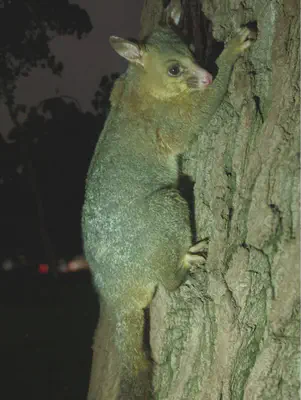 23 April 2020 - West Melbourne, Victoria | Description: This little possum was a champ! He loves a little rub, perhaps I was helping him comb his fur. 🤔 Athough I had a nightmare of possum-roo attacking me in the bedroom, Australian wildlife are quite friendly just so long as you don’t threaten them. This is a common brushtail possum - its scientific name comes from Greek for “furry tailed” and Latin for “little fox”. This one is definitely a furry little fox. They are marsupials, semi-arboreal (tree-living) and nocturnal (sleeping during the day 😸). They are native to Australia. They have adapted to urban environment, used to close contact with humans. Notice the pointed pink snout, long whiskers and very sharp claws for climbing and combing their fur. These guys help to protect the gum trees from the mistletoe parasite by snacking on them. In the wild, they feed on leaves and fruits but in urban areas, they are opportunistic and inventive, they will eat anything they can find. Thus, they have been surviving in this Anthropocene period and became the most common and least concern possum. |
| Black swan Anatidae Cygnus atratus 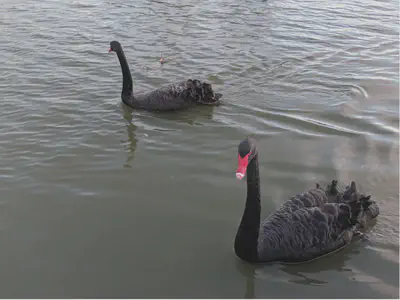 3 May 2020 - Centennial Park, Sydney, NSW | Description: I saw these swans at the popular park near Bondi Beach in NSW. They were picking on the wall of this giant wetland pond, perhaps picking their algae or weed off the wall?. Further reading reveals that they are the only swan in the world with an entirely black color. I saw the white wing tips underneath the black when they turned away. I’d first noticed the distinct redish bill with a white band at its end. They are always in pair I and are mate for life. They would need at least 40 meters to take off and can travel long dstance taking rest during the day. Although with the little amount of wetland region we have, I am unsure if these swans travel out of this park at all. The black swans are biparental, they raise only one youth (cygnet) per season. These cygnets are precocial, they can swim and feed themselves after birth. Their breeding season is from Feb to May in the North and June to Sept in the South. |